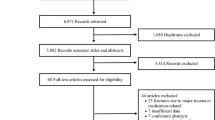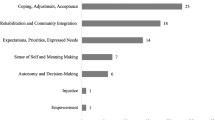Abstract
Study design:
Secondary analysis of existing data.
Objective:
Our objective was to examine the relationship between race–ethnicity and poverty status after spinal cord injury (SCI).
Setting:
A large specialty hospital in the southeastern United States.
Methods:
Participants were 2043 adults with traumatic SCI in the US. Poverty status was measured using criteria from the US Census Bureau.
Results:
Whereas only 14% of non-Hispanic White participants were below the poverty level, 41.3% of non-Hispanic Blacks were in poverty. Logistic regression with three different models identified several significant predictors of poverty, including marital status, years of education, level of education, age and employment status. Non-Hispanic Blacks had 2.75 greater odds of living in poverty after controlling for other factors, including education and employment.
Conclusion:
We may need to consider quality of education and employment to better understand the elevated risk of poverty among non-Hispanic Blacks in the US.
Similar content being viewed by others
Log in or create a free account to read this content
Gain free access to this article, as well as selected content from this journal and more on nature.com
or
References
Young AE, Murphy GC . Employment status after spinal cord injury (1992-2005): a review with implications for interpretation, evaluation, further research, and clinical practice. Int J Rehabil Res 2009; 32: 1–11.
Yasuda S, Wehman P, Targett P, Cifu DX, West M . Return to work after spinal cord injury: a review of recent research. NeuroRehabil 2002; 17: 177–186.
Krause JS, Kewman D, DeVivo MJ, Maynard F, Coker J, Roach MJ et al. Employment after spinal cord injury: an analysis of cases from the Model Spinal Cord Injury Systems. Arch Phys Med Rehabil 1999; 80: 1492–1500.
Berkowitz M, O'Leary P, Kruse DL, Harvey C . An Analysis of Medical and Social Costs. Demos Medical Publishing, Inc: New York, NY, USA. 1998.
Krause JS, Saunders LL, DiPiro ND, Reed KS . Theoretical risk and prevention model for secondary health conditions and mortality: 15 years of research. Top Spinal Cord Inj Rehabil 2013; 19: 15–24.
Phillips VL, Hunsaker AE, Florence CS . Return to work and productive activities following a spinal cord injury: the role of income and insurance. Spinal Cord 2012; 50: 623–626.
Arango-Lasprilla JC, Ketchum JM, Stevens LF, Balcazar F, Wehman P, Forster L et al. Ethnicity/racial differences in employment outcomes following spinal cord injury. NeuroRehabil 2009; 24: 37–46.
Arango-Lasprilla JC, Ketchum JM, Francis K, Lewis A, Premuda P, Wehman P et al. Race, ethnicity, and employment outcomes 1, 5, and 10 years after spinal cord injury: a longitudinal analysis. PM R 2010; 2: 901–910.
DeVivo MJ, Fine PR . Employment status of spinal cord injured patients 3 years after injury. Arch Phys Med Rehabil 1982; 63: 200–203.
Meade M, Lewis A, Jackson M, Hess D . Race employment, and spinal cord injury. Arch Phys Med Rehabil 2004; 85: 1782–1792.
Smart JF, Smart DW . The racial/ethnic demography of disability. J Rehabil 1997; 63: 9–15.
Krause JS, Terza JV, Dismuke C . Earnings among people with spinal cord injury. Arch Phys Med Rehabil 2008; 89: 1474–1481.
Krause JS, Terza JV . Injury and demographic factors predictive of disparities in earnings after spinal cord injury. Arch Phys Med Rehabil 2006; 87: 1318–1326.
DeNavas-Walt C, Proctor BD, Smith JC . Income, Poverty, and Health Insurance Coverage in the United States: 2007. Census Bureau: Washington, DC, USA. 2008 [cited 4 May 2009]; Available from http://www.census.gov/prod/2008pubs/p60-235.pdf.
Dismuke CE, Krause JS, Terza JV . Racial disparities in poverty status among families of individuals with spinal cord injury. Poverty Public Policy 2011; 3 article 9.
The Henry Kaiser Foundation. Poverty Rate by Race/Ethnicity. 2012 [cited 9 September 2013 ]; Available from: http://kff.org/other/state-indicator/poverty-rate-by-raceethnicity.
NSCISC. Annual Statistical Report. University of Alabama: Birmingham, AL, USA. 2011 February 2011.
US Census Bureau OMB Statistical Policy Directive No. 14 Census Bureau: Washington, DC, USA. 1978 Available from: http://www.census.gov/hhes/povmeas/methodology/ombdir14.html.
CDC. Behavioral Risk Factor Surveillance System Survey Questionnaire. US Department of Health and Human Services, Centers for Disease Control and Prevention: Atlanta, GA, USA. 2006 [cited 16 July 2009]; Available from http://www.cdc.gov/brfss/questionnaires/pdf-ques/2006brfss.pdf.
Krause JS, Saunders LL, Acuna J . Gainful employment and risk of mortality after spinal cord injury: effects beyond that of demographic, injury and socioeconomic factors. Spinal Cord 2012; 50: 784–788.
Anderson D, Dumont S, Azzaria L, Le Bourdais M, Noreau L . Determinants of return to work among spinal cord injury patients: a literature review. J Voc Rehabil 2007; 27: 57–68.
Cao Y, Chen Y, DeVivo M . Lifetime direct costs after spinal cord injury. Top Spinal Cord Inj Rehabil 2011; 16: 10–16.
Income, Poverty, and Health Insurance in the United States, Tables & Figures. Census Bureau: Washington, DC, USA. 2011 Available from www.census.gov/hhes/www/poverty/data/incpovhlth/2011/tables.html.
Ennis SR, Rios-Vargas M, Albert NG . The Hispanic Population: 2010. Census Bureau: Washington, DC, USA. 2011.
Vincent GK, Velkoff VA . The Next Four Decades: The older Population in the United States: 2010 to 2050. Census Bureau: Washington, DC, USA. 2010.
Krause JS, Reed KS . Obtaining employment after spinal cord injury: relationship with pre- and post-injury education. Rehabil Counsel Bull 2009; 53: 27–33.
Acknowledgements
The contents of this presentation were developed under grants from the Department of Education, NIDRR Grant numbers H133G050165 and H133A080064 and a Grant from the National Institutes of Health, 1R01 NS 48117. However, those contents do not necessarily represent the policy of the Department of Education or the NIH, and one should not assume endorsement by the Federal Government. We thank the following persons who contributed to the work reported in the manuscript: Richard Aust, Jennifer Coker, Melinda Jarnecke, D’Andra Roper and Dr Lee Saunders.
Author information
Authors and Affiliations
Corresponding author
Ethics declarations
Competing interests
The authors declare no conflict of interest.
Rights and permissions
About this article
Cite this article
Krause, J., Dismuke, C., Acuna, J. et al. Race–ethnicity and poverty after spinal cord injury. Spinal Cord 52, 133–138 (2014). https://doi.org/10.1038/sc.2013.147
Received:
Revised:
Accepted:
Published:
Issue date:
DOI: https://doi.org/10.1038/sc.2013.147
Keywords
This article is cited by
-
The association between secondary health conditions and indirect costs after spinal cord injury
Spinal Cord (2021)
-
Polypharmacy and adverse drug events among propensity score matched privately insured persons with and without spinal cord injury
Spinal Cord (2018)
-
Thermodysregulation in persons with spinal cord injury: case series on use of the autonomic standards
Spinal Cord Series and Cases (2017)
-
Integrated services and early intervention in the vocational rehabilitation of people with spinal cord injuries
Spinal Cord Series and Cases (2017)
-
Race and rehabilitation following spinal cord injury: equality of access for American Indians/Alaska Natives compared to other racial groups
Injury Epidemiology (2015)



